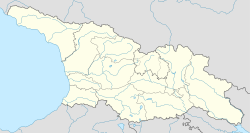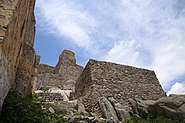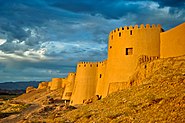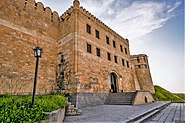
Khosrow I, traditionally known by his epithet of Anushirvan, was the Sasanian King of Kings of Iran from 531 to 579. He was the son and successor of Kavad I.
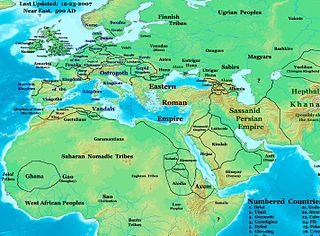
The Sabirs (Savirs, Suars, Sawar, Sawirk among others; were a nomadic Turkic equestrians who lived in the north of the Caucasus beginning in the late-5th -7th century, on the eastern shores of the Black Sea, in the Kuban area, and possibly came from Western Siberia. They were skilled in warfare, used siege machinery, had a large army and were boat-builders. They were also referred to as Huns, a title applied to various Eurasian nomadic tribes in the Pontic-Caspian Steppe during late antiquity. Sabirs led incursions into Transcaucasia in the late-400s/early-500s, but quickly began serving as soldiers and mercenaries during the Byzantine-Sasanian Wars on both sides. Their alliance with the Byzantines laid the basis for the later Khazar-Byzantine alliance.
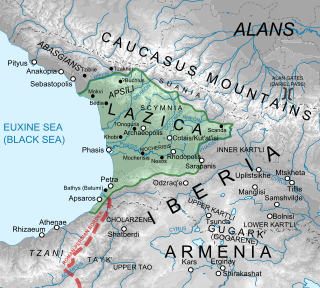
The Lazic War, also known as the Colchidian War or in Georgian historiography as the Great War of Egrisi was fought between the Byzantine Empire and the Sasanian Empire for control of the ancient Georgian region of Lazica. The Lazic War lasted for twenty years, from 541 to 562, with varying success and ended in a victory for the Persians, who obtained an annual tribute in exchange for ending the war. The Lazic War is narrated in detail in the works of Procopius of Caesarea and Agathias.
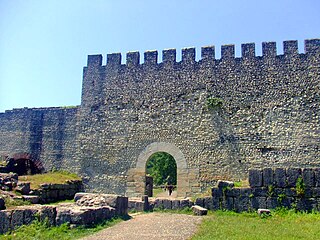
Nokalakevi also known as Archaeopolis and Tsikhegoji and according to some sources "Djikha Kvinji" in Mingrelian, is a village and archaeological site in the Senaki municipality, Samegrelo-Zemo Svaneti region, Georgia.
The Roman–Persian Wars, also known as the Roman–Iranian Wars, were a series of conflicts between states of the Greco-Roman world and two successive Iranian empires: the Parthian and the Sasanian. Battles between the Parthian Empire and the Roman Republic began in 54 BC; wars began under the late Republic, and continued through the Roman and Sasanian empires. A plethora of vassal kingdoms and allied nomadic nations in the form of buffer states and proxies also played a role. The wars were ended by the early Muslim conquests, which led to the fall of the Sasanian Empire and huge territorial losses for the Byzantine Empire, shortly after the end of the last war between them.

Mazun was a Sasanian province in Late Antiquity, which corresponded to modern-day Bahrain, Qatar, United Arab Emirates, and the northern half of Oman. The province served as a Sasanian outpost and played an important role in the Sasanian efforts to gain control over the Indian Ocean trade, and to establish their dominance in the wealthy regions of Hadramaut and Yemen.
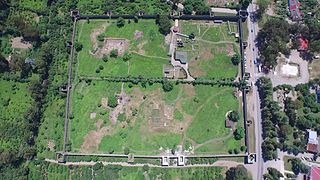
Gonio fortress is a Roman fortification in Adjara, Georgia, on the Black Sea, 15 km south of Batumi, at the mouth of the Chorokhi river. The village sits 4 km north of the Turkish border. Its name was connected with the myth of Medea and her brother Absyrtus.
Circesium, known in Arabic as al-Qarqisiya, was a Roman fortress city near the junction of the Euphrates and Khabur rivers, located at the empire's eastern frontier with the Sasanian Empire. Procopius calls it the "farthest fortress" of the Romans. It was later conquered by the Muslim Arabs in the 7th century and was often a point of contention between various Muslim states due to its strategic location between Syria and Iraq. The modern town of al-Busayra corresponds with the site of Circesium.
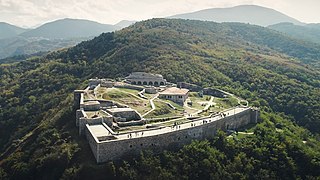
Prizren Fortress is a hilltop fortification in Prizren in Kosovo. It overlooks the Prizren River which flows through Prizren, which developed around the fortress. The site of the fortress of Prizren has seen habitation and use since the Bronze Age. In late antiquity it was part of the defensive fortification system in western Dardania and was reconstructed in the era of eastern Roman Emperor Justinian. Byzantine rule in the region ended definitively in 1219–20 as the Serbian Nemanjić dynasty controlled the fort until 1371.

The area of Georgia was under Roman control between the 1st century BC and the 7th century AD. This control varied by time and was intermittent over the kingdoms of Colchis and Iberia in the Caucasus region. These kingdoms roughly correspond to some of the western and eastern parts of modern Georgia.
Mihr-Mihroe, in Middle Persian either Mihr-Mihrōē or Mihrmāh-rōy; in Byzantine sources Mermeroes, was a 6th-century Sasanian general, and one of the leading commanders of the Byzantine–Sassanid Wars of the time.

The siege of Phasis took place in 555–556 during the Lazic War between the Byzantine and Sasanian Empires. Expecting an easy victory, the Persians besieged the town of Phasis in Lazica, held by the Byzantines, but were defeated in the ensuing irregular battle. The main source for the siege is the 6th-century historian Agathias.

The National Agency for Cultural Heritage Preservation of Georgia is a government agency in Georgia responsible for preservation, protection, research and promotion of cultural heritage of the country. The agency was established in 2008, bringing several major heritage monument complexes of national and global significance in Georgia under its umbrella. The agency is headed by Director General, a position occupied by the art historian Nikoloz Vacheishvili since November 2008.
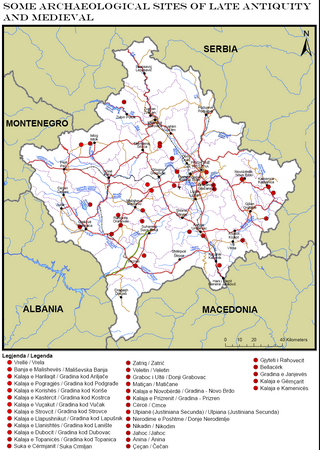
Part of series of articles upon Archaeology of Kosovo

The Ioannina Castle is the fortified old town of the city of Ioannina in northwestern Greece. The present fortification dates largely to the reconstruction under Ali Pasha in the late Ottoman period, but incorporates also pre-existing Byzantine elements.

Sasanian Iberia refers to the period the Kingdom of Iberia was under the suzerainty of the Sasanian Empire. The period includes when it was ruled by Marzbans (governors) appointed by the Sasanid Iranian king, and later through the Principality of Iberia.

Petra was a fortified town on the eastern Black Sea coast, in Lazica in what is now western Georgia. In the 6th century, under the Byzantine emperor Justinian I, it served as an important Eastern Roman outpost in the Caucasus and, due to its strategic location, became a battleground of the 541–562 Lazic War between Rome and Sasanian Persia (Iran). Mainstream scholarly opinion identifies Petra with a ruined settlement of Late Antiquity at the village of Tsikhisdziri in Adjara, southwestern Georgia.
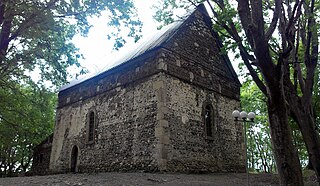
Vartsikhe is a village in the Baghdati Municipality, Imereti, Georgia. It is located in western part of the country, in the Imereti Lowlands, at the confluence of the Rioni and Khanitskali rivers, some 17 km northwest of the town of Baghdati. Its population as of the 2014 census was 1,559.

The defense lines of the Sasanians were part of their military strategy and tactics. They were networks of fortifications, walls, and/or ditches built opposite the territory of the enemies. These defense lines are known from tradition and archaeological evidence.
The siege of Petra was fought in 550 AD, between the Byzantines under general Bessas, and the Sasanian Persian garrison of Petra in the buffer state of Lazica. The strategic fortress had previously been held by the Byzantines before it was seized in 541 by the Sasanian king Khosrow I, and his Lazi allies. This conquest gave the Sassanian Empire access to the Black Sea and marked the beginning of the Lazic War. After a failed attempt to recapture Petra in 549, the Byzantine emperor Justinian I sent an army under Bessas to retake the fortress. The Byzantine historian Procopius described the resulting siege in vivid detail.

